 |
 |
Our enthusiastic and extremely knowledgeable perennials team is here to answer your questions and help you choose the best perennials for your situation. There’s always something in bloom for sun, shade, butterflies, birds or deer resistance as well as a variety of bulbs for your space.
Stroll through our time-tested favorites and introduce yourself to the newest varieties. We garden with perennials too; we love them and it shows!
|
16 found, showing page 1 of 2

Purple-red blooms. Upright dark green-purple foliage. USDA 4-8
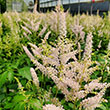
Delicate pinky peach flower spikes crown lacy green leaves. Tolerates deer, heavy shade, and black walnut. USDA 4-8
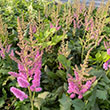
Pink blooms. Dwarf. Tolerates heavy shade, Wet sites & deer. USDA 4-8
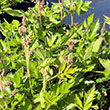
Pink blooms. Tolerates heavy shade, deer, & black walnut. USDA 4-8
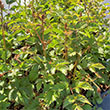
Purple to red blooms and dark green upright foliage. Perfers moist soil. USDA 4-8
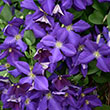
Height: 10 feet
Spread: 24 inches
Sunlight: full sun
Hardiness Zone: 3a
Other Names: Jackman's Clematis
Description:
The granddaddy of clematis, more popular than any other variety and for good reason; this variety features endless waves of rich velvet-blue flowers throughout the season; tough, hardy and thrives with neglect
Ornamental Features:
Jackmanii Clematis features showy royal blue star-shaped flowers with white anthers at the ends of the branches from mid summer to early fall. It has green deciduous foliage. The compound leaves do not develop any appreciable fall color.
Landscape Attributes:
Jackmanii Clematis is a multi-stemmed deciduous woody vine with a twining and trailing habit of growth. Its average texture blends into the landscape, but can be balanced by one or two finer or coarser trees or shrubs for an effective composition.
This is a relatively low maintenance woody vine. It is a Type 3 clematis; each spring it should be pruned back to within a few inches of the ground, as it flowers on new wood of the season. It is a good choice for attracting hummingbirds to your yard. It has no significant negative characteristics.
Jackmanii Clematis is recommended for the following landscape applications:
- Accent
- Hedges/Screening
- General Garden Use
- Container Planting
Planting & Growing:
Jackmanii Clematis will grow to be about 10 feet tall at maturity, with a spread of 24 inches. As a climbing vine, it tends to be leggy near the base and should be underplanted with low-growing facer plants. It should be planted near a fence, trellis or other landscape structure where it can be trained to grow upwards on it, or allowed to trail off a retaining wall or slope. It grows at a medium rate, and under ideal conditions can be expected to live for approximately 20 years.
This woody vine should only be grown in full sunlight. It does best in average to evenly moist conditions, but will not tolerate standing water. It is not particular as to soil type or pH. It is highly tolerant of urban pollution and will even thrive in inner city environments. Consider applying a thick mulch around the root zone in both summer and winter to conserve soil moisture and protect it in exposed locations or colder microclimates. This particular variety is an interspecific hybrid.
Jackmanii Clematis makes a fine choice for the outdoor landscape, but it is also well-suited for use in outdoor pots and containers. Because of its spreading habit of growth, it is ideally suited for use as a 'spiller' in the 'spiller-thriller-filler' container combination; plant it near the edges where it can spill gracefully over the pot. It is even sizeable enough that it can be grown alone in a suitable container. Note that when grown in a container, it may not perform exactly as indicated on the tag - this is to be expected. Also note that when growing plants in outdoor containers and baskets, they may require more frequent waterings than they would in the yard or garden.
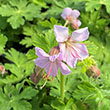
Pinkish-white blooms emerge from dark-pink buds. Bushy, open habit. USDA 4-8
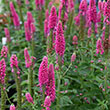
Bright pink blooms. Upright foliage. Clumping. USDA 4-8
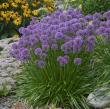
Compact, upright clump of glossy green leaves. Clusters of bright purple flowers blooms in mid-summer. USDA 4-8
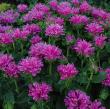
Fragrant and drought-tolerant. Attracts hummingbirds & butterflies. Deer resistant. USDA 4-8
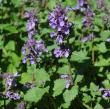
Prolific blue blooms. Fragrant, soft, fine textured foliage. Compact. USDA 4-8
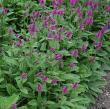
Rose-lavender blooms. Dense glossy foliage. Clumping Habit. USDA 4-8
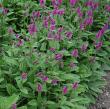
Rose-lavender blooms. Dense glossy foliage. Clumping Habit. USDA 4-8
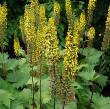
Huge lemon-yellow flower spikes. Deep purple stems. Large green, toothed foliage. USDA 4-8
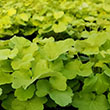
Plant Height: 6 inches
Flower Height: 12 inches
Spacing: 12 inches
Sunlight: full sun, partial shade, full shade
Hardiness Zone: 4a
Other Names: Coralbells, Alumroot
Description:
Dainty spikes of cream colored bells rise from a compact mound of bright lemon foliage with silvery undersides; foliage is more chartreuse in denser shade; amazing contrast to other plants; great versatility; keep soil moist in the heat of summer
Ornamental Features:
Citronelle Coral Bells features dainty spikes of creamy white bell-shaped flowers rising above the foliage from late spring to mid summer. Its attractive crinkled lobed leaves remain lemon yellow in color with curious silver undersides throughout the year.
Landscape Attributes:
Citronelle Coral Bells is a dense herbaceous evergreen perennial with tall flower stalks held atop a low mound of foliage. Its relatively fine texture sets it apart from other garden plants with less refined foliage.
This is a relatively low maintenance plant, and should be cut back in late fall in preparation for winter. It is a good choice for attracting hummingbirds to your yard. It has no significant negative characteristics.
Citronelle Coral Bells is recommended for the following landscape applications:
- Mass Planting
- Rock/Alpine Gardens
- Border Edging
- General Garden Use
- Groundcover
- Container Planting
- Planting & Growing
Citronelle Coral Bells will grow to be only 6 inches tall at maturity extending to 12 inches tall with the flowers, with a spread of 15 inches. When grown in masses or used as a bedding plant, individual plants should be spaced approximately 12 inches apart. Its foliage tends to remain low and dense right to the ground. It grows at a medium rate, and under ideal conditions can be expected to live for approximately 10 years. As an evegreen perennial, this plant will typically keep its form and foliage year-round.
This plant performs well in both full sun and full shade. However, you may want to keep it away from hot, dry locations that receive direct afternoon sun or which get reflected sunlight, such as against the south side of a white wall. It prefers to grow in average to moist conditions, and shouldn't be allowed to dry out. It is not particular as to soil type or pH. It is somewhat tolerant of urban pollution. Consider covering it with a thick layer of mulch in winter to protect it in exposed locations or colder microclimates. This particular variety is an interspecific hybrid. It can be propagated by division; however, as a cultivated variety, be aware that it may be subject to certain restrictions or prohibitions on propagation.
Citronelle Coral Bells is a fine choice for the garden, but it is also a good selection for planting in outdoor pots and containers. It is often used as a 'filler' in the 'spiller-thriller-filler' container combination, providing a mass of flowers and foliage against which the larger thriller plants stand out. Note that when growing plants in outdoor containers and baskets, they may require more frequent waterings than they would in the yard or garden.
16 found, showing page 1 of 2









